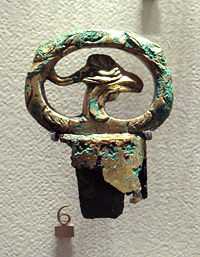In the 7th century Silla allied itself with the Chinese Tang dynasty. In 660, under King Muyeol (654-661), Silla subjugated Baekje. In 668, under King Munmu (King Muyeol's successor) and the General Kim Yu-shin, Silla conquered Goguryeo to its north. Silla then fought for nearly a decade to expel Chinese forces on the peninsula intent on creating Tang colonies there to finally establish a unified kingdom as far north as modern Pyongyang. The northern region of the defunct Goguryeo state later reemerged as Balhae. |
Silla's middle period is characterized by the rising power of the monarchy at the expense of the jingol nobility. This was made possible by the new wealth and prestige garnered as a result of Silla's unification of the peninsula, as well as the monarchy's successful suppression of several armed aristocratic revolts following early upon unification, which afforded the king the opportunity of purging the most powerful families and rivals to central authority. |
 Silla Crown |
Further, for a brief period of about a century from the late 7th to late 8th centuries the monarchy made an attempt to divest aristocratic officialdom of their landed base by instituting a system of salary payments or office land in lieu of the former system whereby aristocratic officials were given grants of land to exploit as salary (the so-called tax villages). |
By the late 8th century, however, these royal initiatives had failed to check the power of the entrenched aristocracy. The mid to late 8th century saw renewed revolts led by branches of the Kim clan which effectively limited royal authority. Most prominent of these was a revolt led by Kim Daegong that persisted for three years. One key evidence of the erosion of kingly authority was the rescinding of the office land system and the reinstitution of the former tax village system as salary land for aristocratic officialdom in 757. |
 Sword hilt decoration (Silla Kingdom),4th-6th century C.E. |
The middle period of Silla came to an end with the assassination of King Hyegong in 780, terminating the kingly line of succession of King Muyeol, the architect of Silla's unification of the peninsula. Hyegong's demise was a bloody one, the culmination of an extended civil war involving most of the kingdom's high-ranking noble families. With Hyegong's death, during the remaining years of Silla the king was reduced to little more than a figurehead as powerful aristocratic families became increasingly independent of central control. |
Thereafter the Silla kingship was fixed in the house of King Wonseong (785ĘC798), though the office itself was continually contested among various branches of the Kim lineage. |
Nevertheless, the middle period of Silla witnessed the state at its zenith, the brief consolidation of royal power, and the attempt to institute a Chinese style bureaucratic system. |
|

